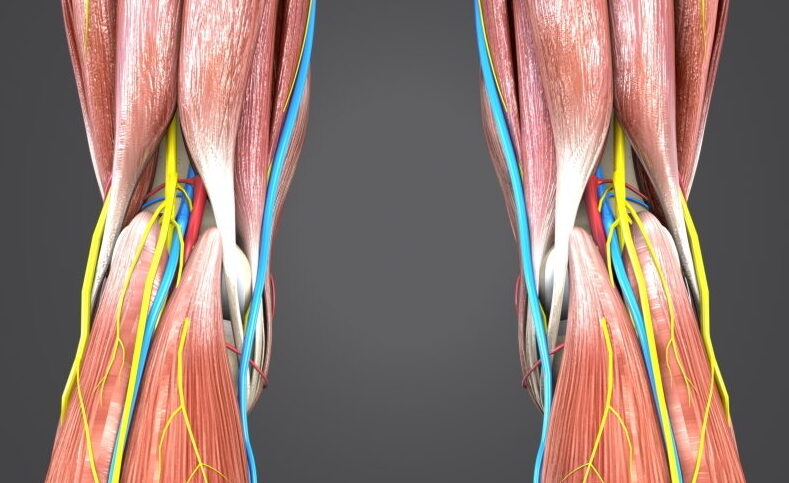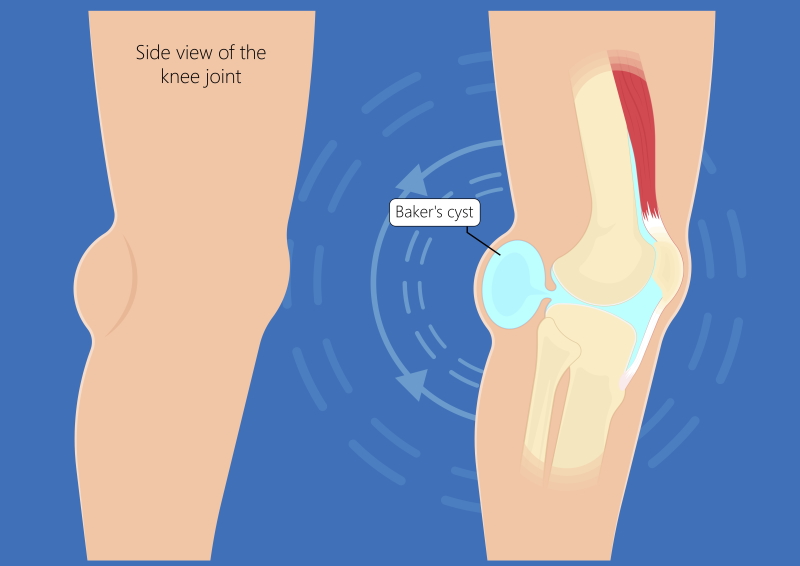Muscles and Tendons at the Back of the Knee

- View Larger Image

Pain behind knee: what should you do?
In general, pain behind the knee is one of the more challenging musculoskeletal problems. There are so many possible causes – muscle tear, tendon, nerve damage, and blood clots. Like most other problems, the key to managing it correctly is an early and accurate diagnosis. So, what are the causes of pain behind the knee, and how do sort out what is causing the problem?
What's behind the knee?
The back of the knee has complicated anatomy.
As well as the knee joint that sits in the middle, there are muscles from the thigh and calf that pass through this area. Firstly, the large hamstring muscles start from the pelvis and pass across the knee to attach to the lower leg bones. In addition, the large calf muscles start at the bottom part of the thigh and cross the knee to form the large Achilles tendon.
Finally, there are important nerves and blood vessels that cross the back of the knee to supply the lower leg and foot.
Common causes of pain behind knee
Where do we start with making an accurate diagnosis? Generally, most doctors use a methodological process to confirm or rule out causes. Firstly, we perform a thorough assessment to test the joints, ligaments, and tendons that pass across the back of the knee. Then, we consider imaging to confirm our thinking. X-rays often pick up major arthritis in the knee. MRI can detect soft tissue problems such as tendonitis or muscle tear. Occasionally, we perform other tests such as blood, ultrasound, or nerve studies depending on the presentation.
Generally, the more common causes of pain behind the knee include:
Arthritis of the knee causing pain behind knee
Osteoarthritis is a common cause of pain behind the knee. Typically, arthritis causes bone spurs leading to inflammation at the back of the knee. Often, you feel tight and restricted in the movement of the knee joint.
Generally, the best form of treatment for knee arthritis is exercise and load management. Also, wearing a knee sleeve can help. Occasionally, we use injection therapy to help with arthritis such as cortisone or platelet-rich plasma.
Meniscal tears
Meniscal or cartilage tears of the knee can cause pain behind the knee – usually more on the side or outside. Most of these tears are degenerative. Sometimes, however, the 'root' of the meniscus tears, where the meniscus attaches to the middle of the knee, tears. In these cases, the meniscus stops acting as a true shock absorber leading to increased stress on the knee joint.
Primarily, treatment of degenerative tears including degenerative 'root' tears is conservative. Exceptions include meniscal tears in younger patients after trauma, root tears, or any knee that causes mechanical symptoms such as locking or giving way.
Baker's cyst

A Baker's cyst is a collection of fluid at the back of the knee. This cyst arises from the knee joint, so swelling of the knee joint will make the cyst bigger. Generally, bigger cysts put pressure on the joints, muscles, and nerves leading to pain.
Typically, a Baker's cyst is confirmed by an ultrasound. Occasionally for cysts that are painful, we drain the cysts using a needle under ultrasound.
Tendon and muscle injuries causing pain behind knee
Tendon injuries often occur in runners due to overload. The tendons most likely to be affected include the hamstring on the inside (semimembranosus) or outside (biceps femoris). Rarely, a small tendon called the popliteus wrapping around the outside of the knee joint can become swollen and painful.
In addition, hamstring muscle tears can occur close to the outside of the knee. Usually, these tears occur about 5cm above the knee joint. It is important to define the exact location of the tear, as location determines the time to return to sport.
Finally, a pulled calf muscle near the knee can also cause pain in this area.
Nerve damage
Pinching of nerves in the low back (sciatica) or the buttock (piriformis syndrome) can cause pain radiating down the leg and into the back of the knee. However, pain isolated to the back of the knee is not usually associated with nerve damage.
DVT (deep venous thrombosis)
Similar to nerve damage, it is rare for deep venous thrombosis or DVT to cause pain at the back of the knee. usually, pain from DVT extends to the calf and inner thigh. Frequently, the ankle and calf are swollen. Some people have an increased risk of DVT such as obesity, cancer, recent surgery, and long haul travel.
Final word from Sportdoctorlondon about pain behind the knee
Pain behind the knee is not straightforward. Some conditions can be life-threatening such as a DVT. Other conditions may need further investigations and treatments. We suggest you see a sports medicine consultant to get an accurate diagnosis and management plan.
Related conditions:
- Torn meniscus
- Meniscal injections
- Baker's cyst
- Injections for knee arthritis
- Effective treatments for knee arthritis
- Pulled calf muscle
Related Posts
Muscles and Tendons at the Back of the Knee
Source: https://sportdoctorlondon.com/pain-behind-knee/
2 Comments
My husband and I walk two miles a day. About every fifteen minutes I have to stop because the pain in thigh and shin is so bad. If I lift my foot up to my thigh it seems to release something and it is like I never had pain, but it only lasts fifteen to twenty minutes
Hi Nancy, exercise-related pain could be due to trapping of nerves from your spine or blockage of blood vessels to your legs. i suggest you see a doctor to get a proper diagnosis.